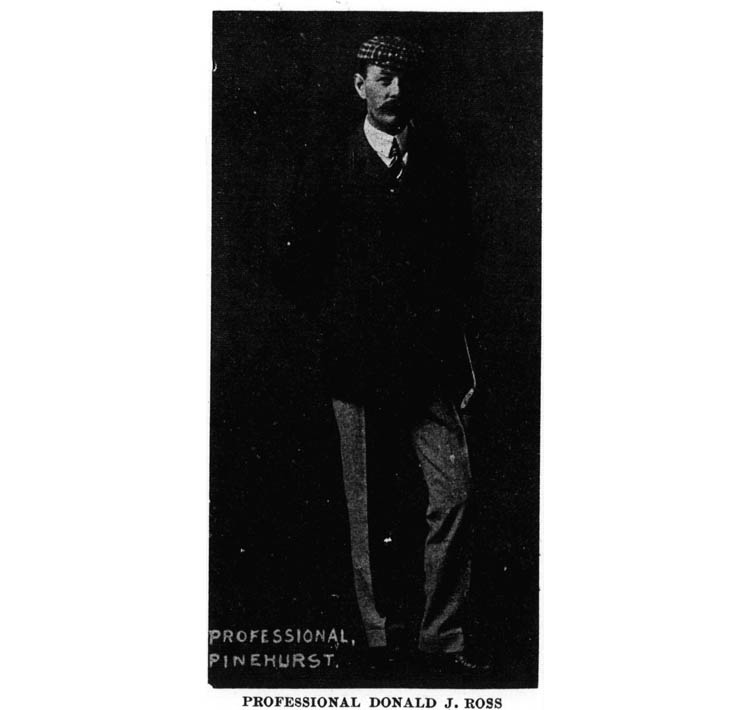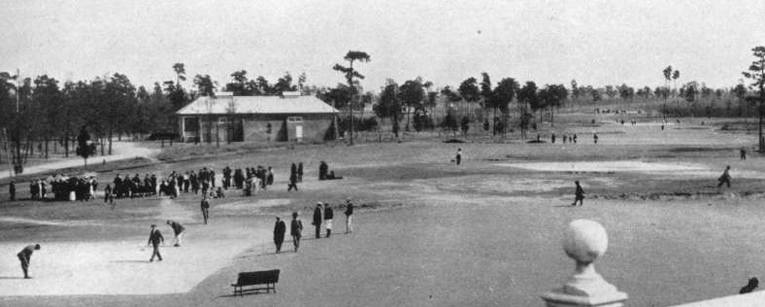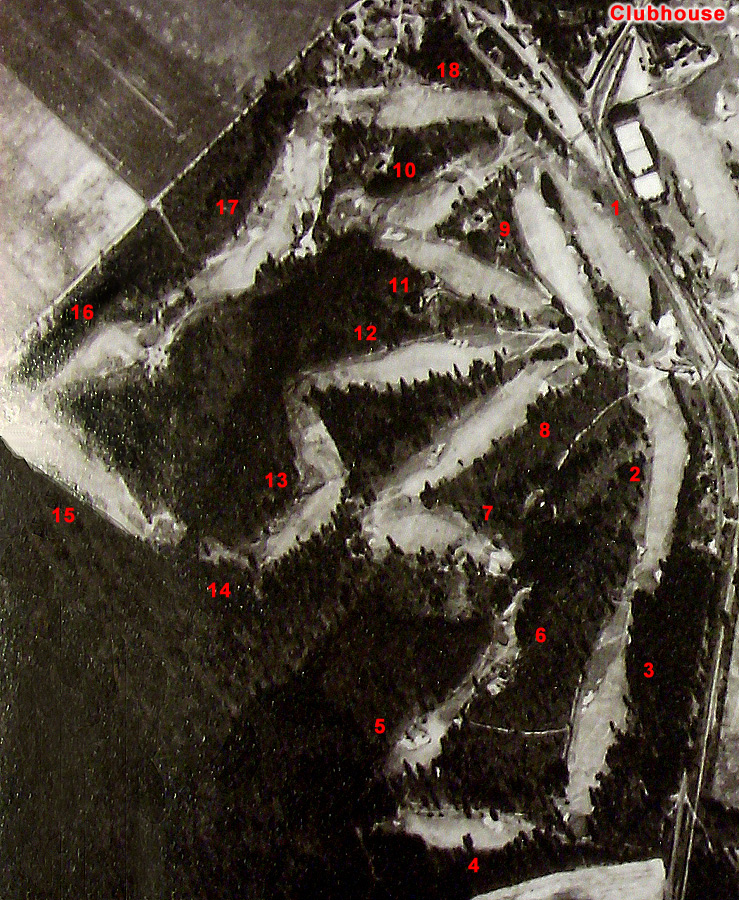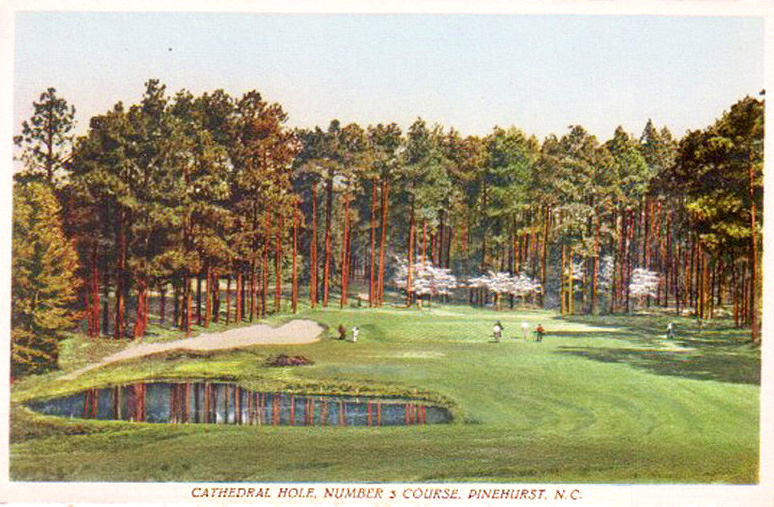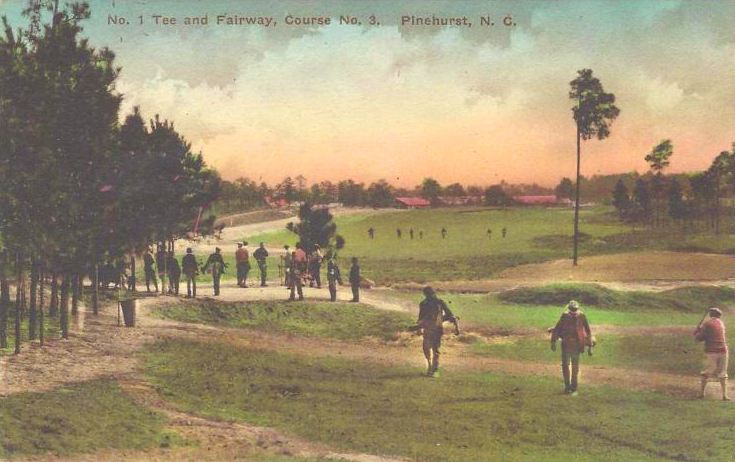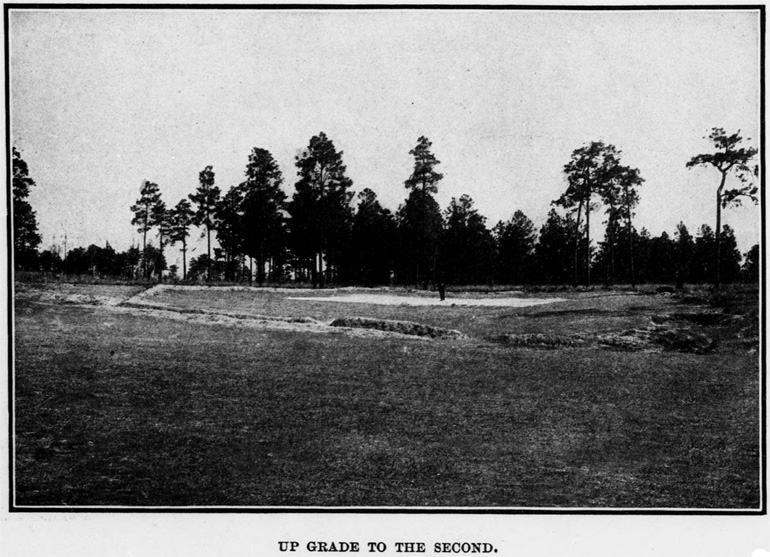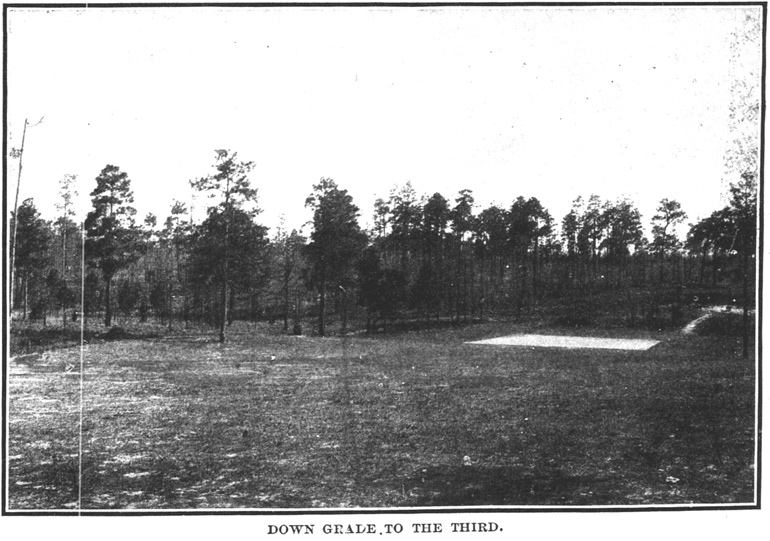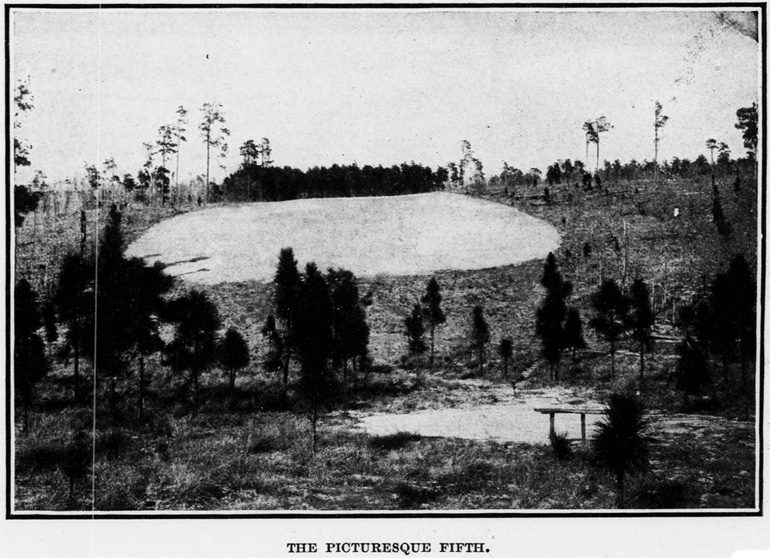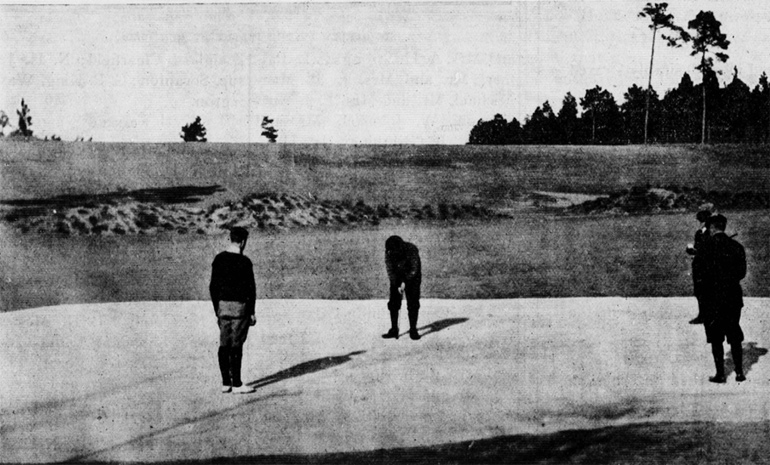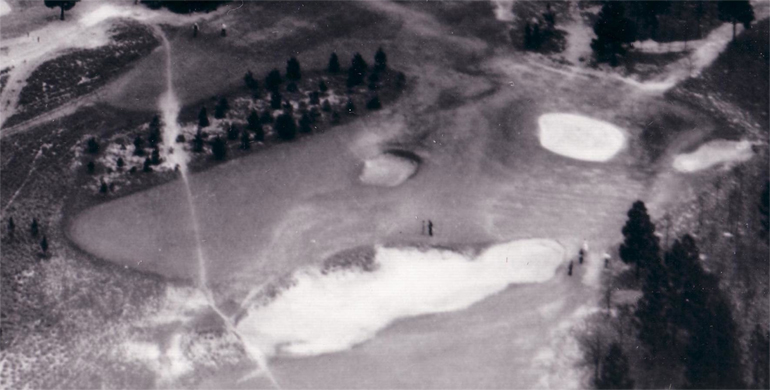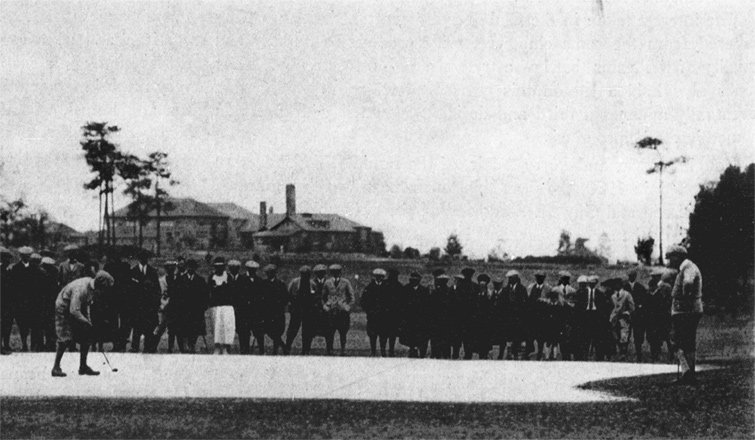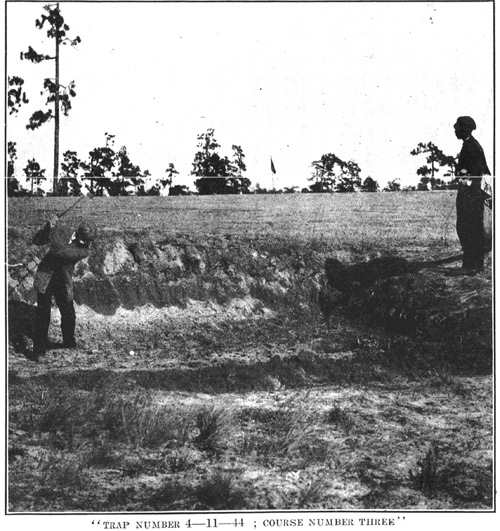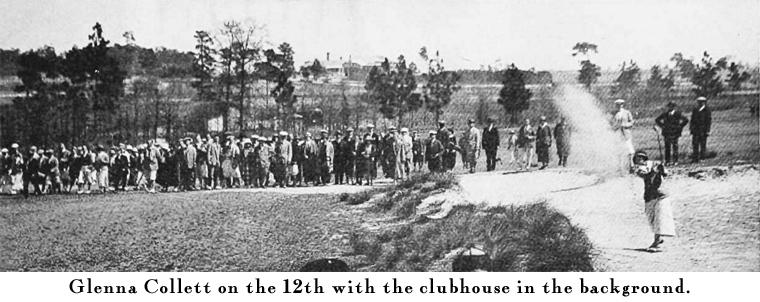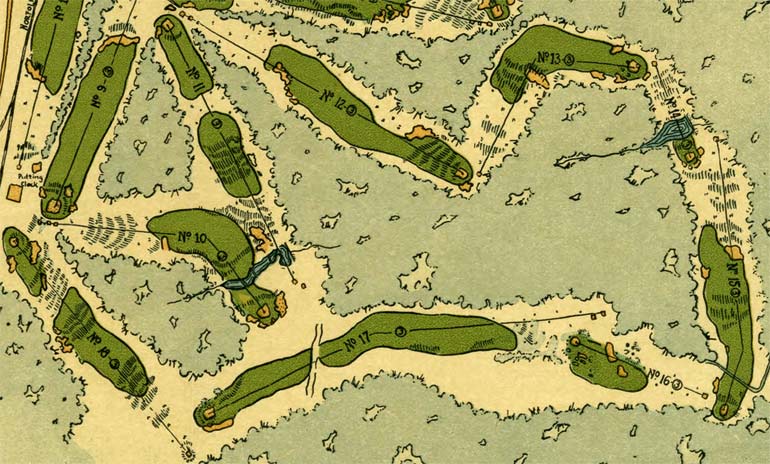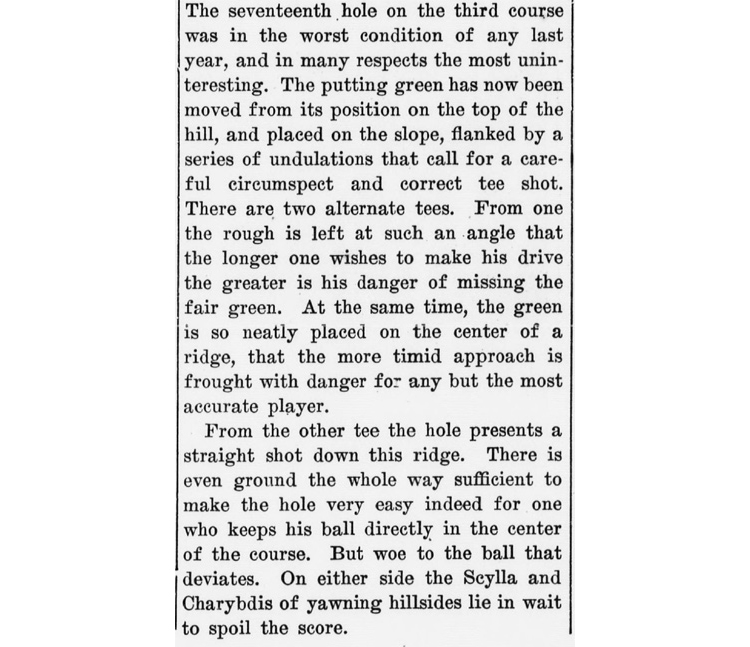The Original Pinehurst No. 3
Chris Buie
March, 2013
![]()
Exhibition matches by the best players of the day were a key feature of the early American golf story. Although this appealing format has essentially gone by the wayside, at one time Pinehurst featured many of the finest examples of the style. Harry Vardon and Bobby Jones were among the many first tier competitors to play highly contested exhibitions along the Carolina fairways. Many years later Palmer and Nicklaus had quite a duel on No. 2 Course for television. That one ended with Nicklaus making a dramatic putt on 18 – from 15 feet behind the green.
A great deal of the more memorable competitions held in Pinehurst have found their way into the history books. However, there was one classic match which has been all but forgotten. In 1923 the reigning (British) Open champion played U.S. Open champion Alec Ross. They were joined by two other top pros – one of whom had just won the French Open – to make it a 4 ball. It was a 36 hole event with one round held in the morning and the second round in the afternoon.
Although No. 2 was available they decided there was another course more suited to a match of this caliber.
The British, French and American Open champions played not one but both rounds on Pinehurst No. 3.
I just don’t think people understand how good those holes are. – Ben Crenshaw on No. 3
By 1910 matters were progressing not too badly for the man from Dornoch. Only a few short years before Mr. Ross had arrived almost penniless on the shores of his adopted homeland. The journey had been prompted by a fairly casual invitation from a Boston professor during a golfing pilgrimage to Scotland the previous summer. Needless to say, the academic was more than a little surprised to find this Scot on his doorstep half frozen from a walk of several miles. But, it was handled with grace and he promptly got in touch with some people who might help this young man on his way.
Walking around hungry and essentially broke through a frozen country where he barely knew a soul was not the most auspicious of starts. However, it took little time at all for this man to establish himself in good stead with the golfing population of Boston. He was an expert at making clubs, taught well, was a quite a player and turned out to have a natural talent for improving the pre-existing courses.
This all around proficiency caught the attention of a local magnate who had only just begun a resort in the Mid South. The guests were remarkably keen on the obscure game and had to be tended to. So the Scot was quickly drafted and found himself traveling down the eastern seaboard toward a place very far away from Dornoch, Scotland.
After freshening up the course that was already going he became involved in lining out a second eighteen. At the time these courses were known as ‘the old’ and ‘the new’. Although there had been some grumbling about difficulty after the new course made its full debut, it didn’t take long for it to be viewed in a more favorable light. Even to this day the resort’s second course is regarded as a work of no small merit by a number of knowledgeable people.
Still, this was not sufficient. Long lines awaited those ready to play around those clearings just south of the hotel. That wouldn’t do – not for this place. And so, with the resort being run by an extremely industrious group entirely dedicated to presenting the finest of offerings the stage was set for yet another golfing area.
With Pinehurst No. 2 showing that the former St. Andrews intern had a solid talent for weaving together a suitable collection of holes they gave him more leeway with the untouched area adjacent to No. 1. Being of a golfing terrain superior to the resort’s previous efforts there was a justified confidence this man could create something worthy of the increasingly prominent guests.
With the rolling and turning landscape providing a scenic as well as playing value of remarkable quality that is exactly what he did. As with full debut of No. 2, there was a bit of criticism in some quarters regarding the difficulty prior to a consensus of high esteem.
From the standpoint of the picturesque the new nine-hole course opened for play last season and which is now in excellent condition, is probably the most attractive in the south and rarely equalled anywhere. From the stretching first to the long ninth, each and every hole is radically different, combining down hill approaches, up hill drives, hidden holes, undulating fair green, water hazards, gentle rises and distinct variety in the way of natural hazards. The additional nine holes which have been laid out on a connecting loop, promise to be fully as attractive. – American Golfer
The commonly held belief is that No. 3 Course opened in 1910. Actually, it opened as a nine holer in 1907.
While much of the staff was busy dealing with the 220,000 tree seedlings, shrubs and flowers which had been imported to beautify the village Ross became absorbed in the new project just across the street from the clubhouse. As ever, there were few to none who thought the manner in which he crafted his way through the virgin forest left anything to be desired. In fact, some of the more notable additions to the vast portfolio he ultimately rendered are to be found on this tract. On Pinehurst No. 3 you can find what is apparently the one and only hole he named (“Cathedral”) and perhaps the most intriguing par-5 he ever created.
Their championship was played over No. 2 course, 100 yards shorter than No. 3, though the par is the same, 71. The latter course except for its sand greens, differs little from a finely laid out northern course. Fine turf, natural rolls, woods, ponds make it very sporty, call for all the shots and make it a pleasure to play. – Golf Illustrated 1920
This third course was rightfully considered the peer of No. 2 for a great number of years. However, the esteem for this course began to wane as the middle of the century approached.
Why?
The primary reason was spectacular nature of the North-South Open. As No. 3 reached a suitable level of conditioning the establishment wasted absolutely no time incorporating it into this major tournament. And for many years half of the tournament was held there. But time moves along and with it Ross concentrated his artistry more and more on turning No. 2 into his quintessential statement. After all, Ross literally lived on the course. It was the first thing he saw from his porch in the morning and the last thing he viewed in daylight as he walked home from his labors. Due to this profound level of immersion with the course there was a symbiotic relationship which none of his others shared.
No. 2 has always been a pet of mine. In building these fine new greens, I’ve been able to carry out many of the changes which I have long visualized but only now have been able to put into practice. – Donald Ross
And so, in time, the North-South became entirely held on No. 2. This also happened to coincide with an era when several of golf’s immortals were waging golfing battles on the most supreme of levels. The mythic nature of these competitions fully captured the imagination of the sporting public – and No. 2 became entrenched in the popular imagination.
—
If you ask the average American golfer what is the best course today the majority are going to say Augusta. Not Cypress Point or Pine Valley or Sand Hills. The average American golfer may very well not even know those courses. It’s a matter of familiarity bred through repeated exposure with glowing words from what suffices as punditry. And when you add a rich layer of extraordinary matches by the best technicians in the world the spell is entire and complete. They are going to be more enamoured with the 16th at Augusta than they are the 16th at Cypress. The fact that the jagged edge which hangs so precipitously over the Pacific is light years superior does not matter. A story has been told and the primacy of a compellingly told story pays little heed to authenticity.
These were the primary factors which led No. 2 to gather an appreciation which far surpassed the course across the street. Had the situation been reversed No. 3 would have been viewed in an entirely different light. The truth of the matter is that at its height No. 3 was an extremely fine course – and to this day has never gotten the recognition it has deserved.
Although today’s modified version still provides a sporty and worthwhile run for the contemporary golfer, if it played in contemporary days as it did at its peak it would most assuredly be somewhere among the upper tier in the golf rich state.
Special interest centers in the new course which was generally enjoyed last season and which is now one of the most interesting, varied and picturesque courses in the south; its special charm being the fact that no two holes are alike. Some idea of its character may be obtained from the views printed in this issue. – Pinehurst Outlook 1910
As the antiquarian imagery which follows will give the reader varying impressions of the course, it may be worthwhile to note that, in this case, a judgement of its quality is not one which should be hastily rendered. Most of the black and white photos on this page are from 1909 – a year before it officially opened. Those images show the course in an almost primordial state. It would be difficult to derive an accurate read on how well the course ultimately played based on what is presented here. Also, some images pre-date a remarkable bunkering which was later added. Therefore, the purpose is largely to give the viewer a rare look from an historic perspective more than providing documents for assessment.
To give you an idea of the discrepancy of the primitive and the fully realized consider the images of the only hole Ross was known to have named: the 6th – “Cathedral”
THE OUTWARD NINE
The first hole sat where today’s second hole resides. Also, it is reversed.
The second hole plays essentially as it did in early days. Only now, it is the second hole of No. 5. The downhill tee shot bends to the right with a moderately uphill approach – more uphill than it appears in the photo.
The 3rd hole originally played to a significantly downhill green. Curiously, Ross did that more than usual on the course. Perhaps lessons were learned about drainage because he largely avoided low lying greens with later designs. Later the green was moved up on the hill beyond – and the little pond left of it was expanded part way through the fairway. It still plays that way today.
The 5th hole was 221 yards and later received an artful bunkering which is still in play – as the 14th hole of No. 5 Course.
The 7th hole was another that featured a downhill green. The blind approach would have had to have been precise as the fairway hazard afforded little room for a run up. Without that hazard the golfer could have been careless with his second shot – just bounding the approach somewhere short of the green and letting it chase toward the green. Ross wasn’t keen on providing shots which did not require thought – especially the approach shots.
Here is what Ran Morrissett had to say about the original 8th hole:
That is an unbelievable bunker, both for its size and position and there is nothing else like it in the sandhills of Moore County. What a shame re: its loss! In fact, in studying it more and more, where else in the country does a bunker of such size/magnitude dominate a par five hole like this Hell version once did? Surely, some modern architects have successfully employed such a stratagem. What are the best examples?? Obviously, Old Mac’s 6th has a Hell Bunker but where else and how about one that plays on such a diagonal?
The 443 yard uphill 8th was easily one of the most interesting three shotters Ross ever did. Certainly, it is one of his best. The key being the second shot. The player had three options. Short right of the mammoth bunker, left or over.
The 9th (today’s 18th on No. 5) featured bunkering which came into play on the 1st hole as well. Below the 1st fairway is at the top with the 9th at the bottom.
The 9th finished just down the hill from the clubhouse.
Before turning our attentions to the inward nine let’s have a look at the rough hewn look from the earliest days.
The following is the former clay quarry which one hit over – or tried to hit over – on the 7th hole.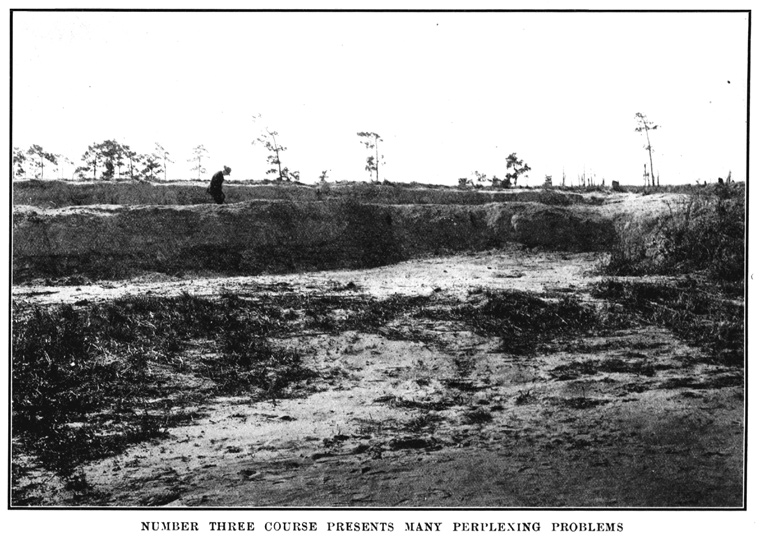
![]()

THE INWARD NINE
The original idea was to have two nine hole courses rather than a third eighteen. The idea being that some preferred the occasional short round rather than a full eighteen. This is another example of the ethos which guided the resort from the beginning. That is, virtually every wish and inclination of the visitors was responded to in an exemplary fashion. Overall, the continual evolution and refinement of every aspect of the village was an enormously complex enterprise. Yet, they did not merely respond to the needs and desires – they pushed beyond the cutting edge of the times in innumerable ways and moved into revolutionary territories.
It was a staggering achievement.
And as all village matters were continually evolving, so did the concept of this course. The idea of two nine hole courses quickly evolved into making it a standard eighteen hole course. However, the original concept remains in that both the outward and inward nines begin and finish in the same place just across the road from the clubhouse.
The inward segues with the outward exactly as you would expect. The terrain, style and challenge of design are very similar and provide a clear sense of continuity. Rare is the Donald Ross course where the two halves don’t look like they belong together. That the seams go unnoticed is a tribute to a masterfully skilled hand.
As the image bank is not exactly overflowing with those grainy visuals of yore lets concentrate on some of the stand out efforts by Mr. Ross.
The 372 yard 10th hole (today’s 3rd) is particularly good terrain used particularly well. A generous driving area leads to a sharp downturn about 220 yards out. Beyond that was once a stream about 50 yards farther along which, alas, is no more. The approach was then played to a green complex perfectly seated on a hill. Except for the absence of the stream and some narrowing it plays the same today.
After some rather challenging holes the golfer was given something of a respite with the shortish 14th (today’s 7th).

As with all the holes, there was a visual evolution from the rough hewn to an ornate display which sent the photographers grasping for more film. The hole still played the same – and actually still does to this day.
Mind you, the transformation from a truly desolate wilderness to a lush landscape is not something which just happened. It was due to Leonard Tufts drafting a highly skilled German by the name of Otto Katzenstein to oversee this large scale aspect of the resort. In addition to the enormous importation of flora and fauna Katzenstein prized some of the native plants such as wire grass. His cultivation of such indigenous plants puzzled the local population.
While Otto tended to a vast number of horticultural matters it was Frank Maples and Ross himself who were primarily responsible for the golfing grounds. They spent decades experimenting with grassing formulas – not always successfully. Ultimately, they found bermuda with a fertilization program that lasted the summer worked best for golfing purposes.
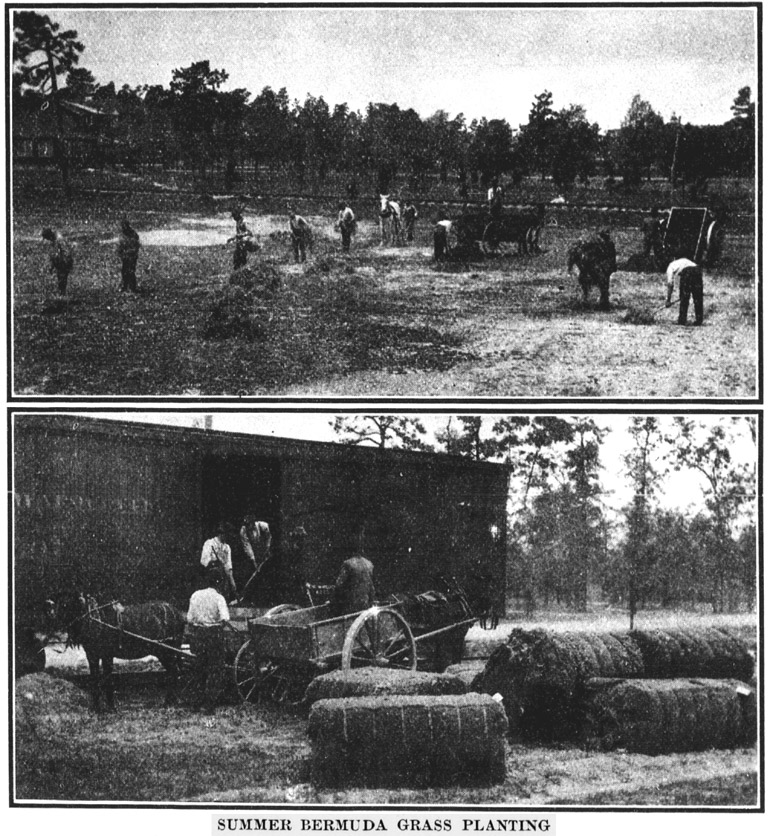
Moving back to design, if the 8th hole was one of Ross’s very best 3 shot holes the original version of the 17th (today’s 15th) provided a very worthy companion piece. Although the extant records leave something to be desired it is clear the 17th was unique and dramatic.
The original version played 100 yards longer with both the tee and (most likely) the green stretched further than you will find them today. The tee shot played sharply downhill to a fairway which canted noticeably left to right. As with the 8th the key shot was the second one which had to contend with a slanted ravine.
The Pinehurst courses are filled with remnants of the earlier ages. Here is how the ravine plays today.
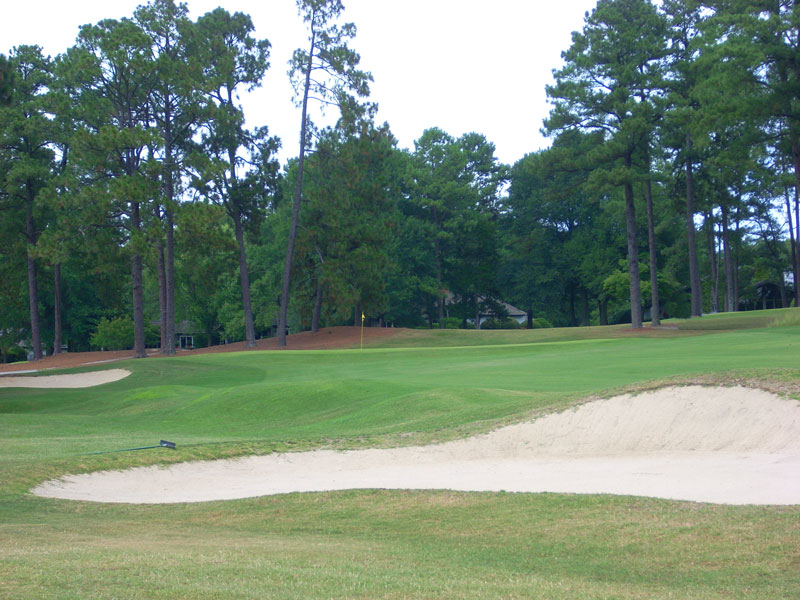
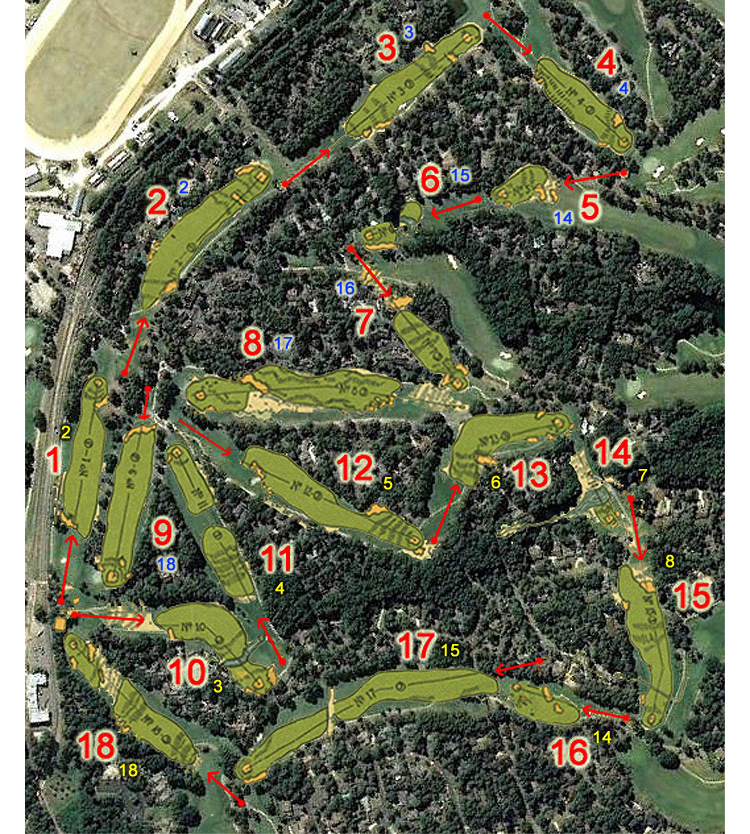
This is a pretty accurate scale superimposition of the original holes on a current aerial. The large red numbers show the original route. The smaller numbers indicate the current hole numbers: yellow for No. 3 and blue for No. 5
Epilogue
Ross designed, literally, hundreds of courses. But, the four courses as one whole were without a doubt his magnum opus. And until the grass greens and nuances were worked into No. 2, it was No. 3 that was the golden child. It was tougher, far more scenic and with clearly superior terrain. Ultimately, it bore the brunt of modernization and housing even more than the others.
The modernization was pursued with good intent. Good intentions guided their efforts even before James Tufts personally drove the first stake into the barren ground and said “this is the center of the village”. The difference – and it was a dramatic difference – was that the early guidance of the vast tract never, ever stopped with good intentions. Not a single time. Not only did they provide the best available – they forged into uncharted territory. That path was not without its mistakes. For instance, at one point No. 2 took a very incongruent path down and back up a sharp hill which was not really suitable for great golfing.
With any elaborate and complex endeavor which travels through many eras the occasional false step is to be expected. However, the salient point here is that the early guardians always corrected the misguided efforts. Their iron clad resolve to ultimately bring each aspect of both the courses and the resort to the best possible level was unwavering.
The guiding star for their decisions was: what is the best way to handle the issue at hand? Sure, there was on occasion expedience and delay in bringing various elements of the long running drama to a fitting outcome. But those were rare and mere way stations on the larger journey toward a plateau of spectacular brilliance. At its peak this place really was the magical golfing dreamworld. There are any number of historic accounts of people’s first visit to the veranda which looks out over Ross’s vast masterwork. It took their breath away.
As you know, the courses gradually moved to an era in which, to a significant degree, they became something akin to standard retirement fare.
That is not what Pinehurst is supposed to be.
The question is: how are the courses going to be guided through the coming years?
Shall the decision be – as it was in the early days – to make a journey toward bringing them to the best level possible? If that is the case then, without the slightest doubt, there should be a long hard look at how Ross had courses 1,3 and 4 in the late ’30’s to late ’40’s.
Does anyone think there is a way to present these courses in a manner which is superior to that?
The exquisite look and playability of the Ross courses at their peak in the late 30’s and into the 40’s should be central to considerations of how the resort progresses through the decades. That is precisely what brought the magic back to No. 2. If advanced thinking is applied to that effort then a great deal more of the Ross virtuosity can be uncovered amongst the rest than one would suppose. For that to happen there has to be the same quest for supreme quality that the early leaders unremittingly brought to bear for so many years. Pursuing that as brilliantly as the recent No. 2 restoration has been conducted will return the resort to a profound ambiance which only a few of the supreme destinations possess.
Ross perfected these courses.
The way forward is by looking back.
Chris Buie is the author of The Early Days of Pinehurst
Since the more intangible dimension is such a key element of this story let’s have a look at an example which may help put this elusive aspect in a framework which makes the subject a bit more comprehensible. In this case, a consideration of how this dynamic plays out at St. Andrews would illustrate it best.
Why do you think thousands of people travel thousands of miles and spend thousands of their hard earned each year in St. Andrews? Do you think it is just for the incomparable nuances of the course alone?
Let’s hypothetically say a precise replica of the old course magically sprung up on some suitable shoreline far away from Scotland…but without the epic narrative – the mythic dimension. No ecstatic matador putts by Seve, no Old Tom Morris keeping a watchful, grandfatherly eye on his beloved home, no Bobby Jones being hoisted by the citizens of golf’s epicenter…
The hypothetical course would be a very good experience – but it would not even be remotely close to experiencing the authentic venue. Such stories – and innumerable others – naturally accumulate and weave themselves together to create a pervasive ambiance which profoundly affects those who make the pilgrimage. Actually, the potency is of such an uncommon order that it often reaches even those far beyond the shore lines of the original home. It even reaches those entirely outside the world of golfing.
These rather etheric matters are not so easy to define – but they are quite easy to sense – and their value to the health of the individual may not be appreciated to the level it warrants.
It is a core element of the sport. Yet it receives a scant amount of discussion. It is from this region that the loftier parts of the game arise. An enmeshment with the larger story evokes enormously life enriching qualities in the participant. Think about someone standing still for a moment on one of those ancient greens waiting for their partner to putt out with a breeze from the bay rising and making its way along the old gray town – seagulls in the distance. It is a sublime experience but one which buffets the spirits of the individual for the rest of their days.
Actually, it is not necessary to comprehend this spellbinding quality. Simply experiencing it is what it is really about. However, as relates to this story, it is important to realize that the extra-ordinary experience requires certain elements to be present. In the highest order of these experiences you will find the beguiling remnants of stories which define the place. The stories which reach back to antiquity give the place a resonance which can not be manufactured or duplicated – even by the very best of designs. The best of designs will give you a fabulous experience that leaves little to be desired but they will not have that certain unquantifiable sense that can only be found among links that are enriched with the folk tales and the myths. A place where this element is central to the experience offers the golfer something that is as valuable as it is rare.
Although no other course can touch the St. Andrews experience, there are a few in the States which echo to some degree that mythic aspect of the one and only. Pinehurst is one of the handful which possesses a fulfilling amount of that ambiance which can only be found among those places who’s memory is abundant with dense layers of compelling folklore. And so, in the long run that is something for the resort to retain, polish and be kept at the center of the considerations which will inform the inevitable progression through future decades.
By navigating the way through those future decades with this as a primary guide point there will be returns of incalculable benefit not only to the club and its visitors – but also to the many who for whatever reason remain at a distance…in a physical sense. There must surely be any number of enthusiasts in some of the more remote corners who love the sport and dream of it and are as captivated by it as anyone. Pinehurst is for them too. Just as are all the other immortal golfing points which make up the larger story. A story which exerts a mysterious power to enliven individuals in a manner not quite like anything else.
THE END



